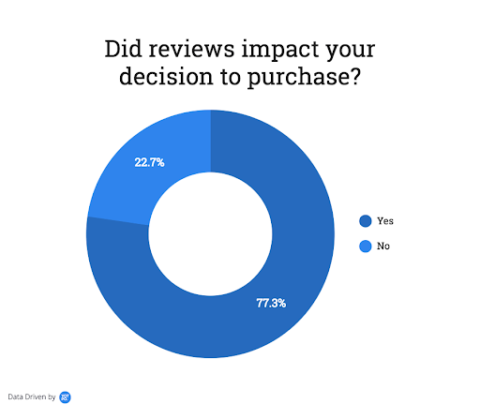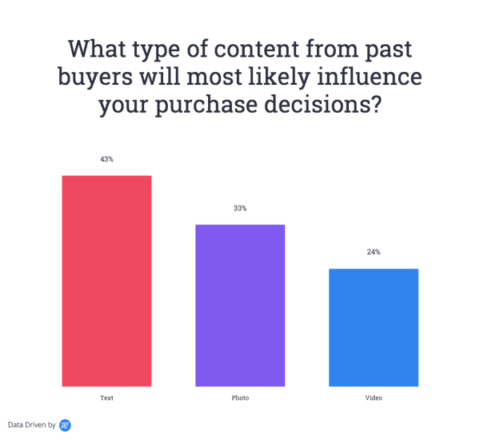Social proof is a psychological experience that happens when people assume the actions of others reflect the accurate behavior in that exact situation.
People who are unsure of how to act in a given situation will look to responses from others to guide their response.
Social proof is not a new concept. Testimonials in advertising and marketing have been used for decades.
However, the introduction of the Internet was essential in bringing consumers (and their feedback) together like never before.
And now, with the proliferation of social media platforms like Facebook, Instagram and others, access to social proof has become part of our daily lives, making it more effective.
Because consumers are heavily influenced by the actions and recommendations of others, social proof is extremely valuable for retailers that want to boost their ecommerce conversion rates.
Social proof can come in many different forms – ranging from customer reviews to industry or media awards, paid influencer endorsements, or a testimonial from a trendsetter on social media.
Why Social Proof Is Important
A company might have the best product in the world, but if no one knows about it it’s not going to sell.
This is why social proof becomes so important for retailers, particularly for those direct-to-consumer (D2C) brands that are online only.
The most trusted example of social proof is the online review.
A glowing review from a celebrity influencer can turn an unknown product or company into a trendsetting sensation overnight.
Before social media, we saw unknown products and tiny shops gain notoriety when Oprah named them on her Favorite Things list.
Today all it takes is an Instagram post from Taylor Swift or a member of the Kardashian clan to boost the presence of a fledgling retailer and place it directly in the spotlight.
The data backs it up. According to our proprietary data at Yotpo, on average 77% of online shoppers incorporate the reviews the read into their purchase decision.

Depending on the product, the influence of reviews may vary.
For example, when it comes to beauty products specifically, a Yotpo survey from earlier this year found that:
- 44.7% of women feel customer reviews are their biggest influence in deciding to make a purchase from a specific brand.
- Referrals from friends come in second at 44.5%.
In this instance, both examples of social proof outpaced:
- TV commercials (17.7%).
- Digital and social media ads (10.2%).
- Offline ads (6.8%).

More recently, Yotpo conducted a survey about fashion purchases and whopping 98% of those surveyed said authentic customer reviews are the most important factor that helps them decide if they are going to make a purchase.

In addition to customer reviews, a variety of user-generated content (UGC) from your customers can be a social proof gold mine.
To attract the customers you want and increase sales, you can use everything from:
- Customer photos and videos.
- Instagram Stories and Highlights.
- Customer communities that are fueled by loyal customers.
Here’s a rundown of the most important social proof elements to consider adding to a website, as well as examples of how some of today’s leading D2C brands are using them successfully.
1. The Customer Reviews Have It
We’ve already addressed how customer reviews may be the most critical social proof a company should use.
If a company can only start with one program, customer reviews should be it. Here’s why.
- 87% of online shoppers conduct online research before ever making a purchase.
- 61% read product reviews to gather information about the product they want to buy.
When potential customers see positive reviews and photos from past customers, they become more confident in their purchasing decision.
2. A Picture Is Worth Thousands of Dollars in Sales
Did you know that 77% of consumers believe photos from customers affect their decision to purchase more than professional photos from brands?
Showing shoppers user-generated content like photos can play a critical role in influencing product purchases.
Customers are the most authentic representation of a brand, so incorporating their photos into a website helps build trust, spark product discovery, and encourage purchase.
However, if you decide to include photos do it strategically to maximize their impact. Two tips to keep in mind as you get started:
- Take the time and care to display the right photos, in the right galleries, at the most critical points during the customer journey. A thoughtful approach about photo placement will resonate more with shoppers than if they are just inundated with photos
- Build an experience that is consistent and visually on-brand across your site. Shoppers can be sensitive to visuals that seem “out of place.” You want to draw them in, in a pleasing way, not have them leave your site wondering about your site design choices.
3. Customizable Layouts Are Cool & Can Inspire a Call-to-Action
Each page on your website serves a distinct purpose. Whether the goal is to inspire, discover, educate or transact, customer photos can boost the page’s effectiveness.
Photo layouts can be a great way to inspire shoppers. To ensure they are truly effective, they need to be designed to complement the page and reinforce its intended call-to-action (CTA).
This is where keeping the previous tips top-of-mind can be very useful because the choices seem endless.
There are a variety of photo layouts to choose from that would be enticing to customers – a clean grid, creative collage, or fanciful carousel layout are all popular.
After that, it’s all about eye appeal and functionality (i.e., size of the images and spacing), giving shoppers a way to interact with a CTA to purchase or simply clicking a heart on a product they love.
4. It Isn’t Enough to Be a Brand – Be a Storyteller
There’s no doubt that Instagram is a critical element to consider for any social proof strategy.
One of its most powerful abilities goes beyond mere images. It enables its users to create Stories and Highlights about their lives, as well as the products they purchase and love.
These two popular Instagram features provide businesses with an opportunity to feature Stories, not just photos, on their sites. The possibilities are endless.
You can choose to run Stories alongside customer reviews.
Want to do something more creative?
Showcase them in a regular “X Brand” Instagram Story feature on the site that inspires customers to create and submit their own Stories for a chance to be in the spotlight.
To date, about only 4% of brands have started to leverage Instagram stories as social proof. It’s a lost opportunity for the other 96%.
Why?
Because 300 million Instagram users interact with Stories every day. Brands are failing to leverage one of the largest growing UGC channels available.
Quip, a D2C toothbrush startup, made reviews its first category of Stories Highlights, making it nearly impossible for people to miss when browsing through their Instagram accounts.
The Stories inside collect reviews from all across social media, providing social proof that appeals to the needs of a variety of potential customers.
5. Build a Community & Customers May Stay Forever
Today’s most successful D2C brands build shared values, products, and customer experiences to appeal to their ideal customers. They leverage their audience to share thoughts with their community.
The right combination of social proof (reviews, recommendations, images and more) can lay the foundation for something more meaningful and powerful – the creation of a brand community.
Here are some steps to community creation that successful brands have used to create their loyal and engaged brand communities.
- Create a space that provides an informed source of relevant and specific feedback
- Give customers a place or forum to gather online. A sense of belonging will help form a strong emotional bond to your brand, generating loyalty, and repeat purchases.
- New customers get brand exposure from like-minded existing customers in the form of authentic word-of-mouth marketing.
Glossier, one of the fastest-growing brands in ecommerce, is one of the leading examples of how a brand can build an incredibly engaged and loyal community.
There were several building blocks that Glossier used to do this, such as:
- Tailoring their products specifically for their audience.
- Introducing a range of customer experiences that have spanned purchase.
- Sharing an unboxing moment.
- Highlighting pop-up shops.
- Sharing customer reviews and recommendations across social media channels.
By closely nurturing this community, Glossier has developed not only brand awareness but has also established itself as one of the most dominant brands in the beauty industry.
More Resources:
- 7 Types of Social Proof to Grow Your Ecommerce Sales
- 3 Ways Social Proof Boosts Customer Acquisition & ROI
- Ecommerce Marketing in 2019: The Definitive Guide
Image Credits
All screenshots taken by author, August 2019


